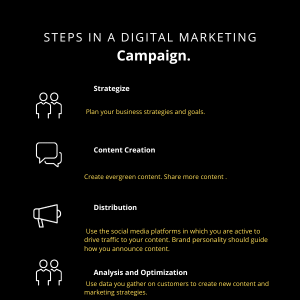Now, this is important. The first step in creating any good digital marketing strategy is determining what the business wants to achieve. And so we will delve into;
- What is digital marketing?
- What are the benefits of digital marketing?
- What are the different digital marketing types?
- Steps in a digital marketing campaign.
What is Digital Marketing?
Digital marketing is the act of advertising products and services to consumers and businesses online. Internet-based systems called “digital marketing channels” can generate and transport product from a producer to a consumer using digital networks.
Though a variety of digital channels make it possible, the fundamental aim for an advertiser is to identify the channels that result in the most two-way communication and the best overall ROI (return on investment).
What are the Benefits?
If you’re establishing a business, you understand how crucial it is to select the best marketing plan. The problem is, many people believe large corporations are the only ones who should engage in digital marketing. However, in reality, any business can profit from it. I’ll explain the advantages;
- Reach a larger audience: Compared to traditional marketing strategies, businesses will engage with a larger audience quickly and affordably.
- Better engagement and improved customer connections: It enables you to communicate with and develop better relationships with your customers. By giving them personalised content. Increasing your understanding of their preferences will help you make more sales.
- More entertaining content: Information is now entertaining thanks to digital media, which attracts consumers and makes their experience more pleasurable.
- More adaptability: By making the best use of the technology at your disposal, digital marketing enables you to customize your marketing messages to particular demographics.
- Increase lead generation: You can increase lead generation by giving clients a simple way to identify your business and learn about your goods or services.
- Save time and money by becoming more effective and economical.
- Boost conversion rates: The number of purchases or enquiries you get from your website by implementing efficient methods will increase.
What are the Different Digital Marketing Types?
There is a variety of digital marketing. For example, the most popular ones include SEO, SEM, PPC and social media marketing. However, it’s crucial to know what they are if you’re a business owner or marketing expert so you can pick the best ones for your company. And so I’ll walk you through them;
- Pay-per-click (PPC) advertising. With this type of marketing, you pay a price each time customers click your ad. Google AdWords gives us the ability to achieve this. Brands like it because it enables companies to target their ads for particular demographics, increasing the likelihood that their intended audience will see their adverts.
- Email Marketing. You send advertisements or newsletters to a list of subscribers via email.
- Search engine optimization (SEO). For this type, you enhance a website’s visibility and rating in search engine results pages (SERPs). The likelihood that visitors will find your website increases with its rating. You can accomplish this by optimizing the content, architecture, and on-page components, including titles and tags. Although it is a long-term technique that may take months or even years to show results, it is a potent way to drive organic traffic to your website.
- Social media marketing. It is when you produce and share content such blogs, pictures, and videos on online platforms to promote a brand and improve website traffic.
Steps in a Digital Marketing Campaign.
A digital marketing campaign is a collection of coordinated actions that all aim toward the same goal. It may be anything from generating leads or raising brand awareness. Here’s how the steps involved in a good digital marketing campaign work;
Strategize
The first step in digital marketing is to plan your business strategies and goals. You need to ask yourself what you want to achieve and how you will make it happen. Knowing what you want to achieve will enable you to focus your efforts on marketing campaigns and use marketing strategies that affect the appropriate business metrics.
After establishing your goals, you’ll need to create key performance indicators (KPIs).
But what are they? KPIs are the metrics used to determine whether you meet your business objectives. It will keep your strategy on track. You won’t know if your content marketing strategy is working. Or supporting your larger business goals unless you measure yourself against them.
Content Creation
Evergreen Content
When creating content, keep evergreen in mind. What do I mean? Evergreen content is one that people can enjoy regardless of when they make it. For example, customers will always read a blog post about 5 ways to improve a website’s conversion rate. It is timeless and can keep readers interested whenever they come across it. Some examples of evergreen content include:
- Tutorials
- Online tools lists
- Support content or
- FAQs
- E-books
- Resources
Readability
Do you want to make it easier for readers to consume your content? Then make it simple! When an article is unreadable, readers give up in frustration. Readability refers to the design elements rather than the logical sequence or writing style. What do I mean? Your reader will leave if your article font is too small or lacks bold headings. Therefore, it’s helpful to consider how readers will scan your content. Using an F or Z pattern, you know they’ll start at the top and read the headline, then their eyes will go down and across.
Put the most content in the page’s area where you know they will look first. Instead of forcing your readers to read every word, cater to their desire for speed. As a result, as a content marketer, one of your responsibilities is to make your articles easy to skim. Paragraphs should be brief, and lists should be in bullets or italicized.
Finally, you should also share more content because more and better content provides valuable information about your customers.
Distribution
Free Traffic
After you have created some content, use the social media platforms in which you are active to drive traffic to it. A tweet on Twitter, or an update on Facebook, can all be used to drive traffic. When creating text for a social media update, your brand’s personality should guide how you announce new content. For example, if your brand is a clothing line, use a trendy and casual tone in your copy.
Paid Traffic
Paid traffic comes as advertisements that help spread the word about your content. Search engines like google and social media such as Facebook are some places where you can display adverts.
Because of its ability to categorize your visitors and use remarketing, paid traffic may be very successful at generating leads.
Analysis and Optimization
Almost anywhere can provide data. Everywhere a customer goes, they leave little bits of information. These are the ways used to design a marketing strategy:
- Information from owned media.
- Information from websites and apps used for social media.
Information from Owned Media
With information from privately owned media outlets, such as your website; you can use what you gather to create new content and marketing strategies. For example, by analyzing the content on your website, you can determine which posts and pages interest people and create Millennial-focused content.
Your acquisition dashboard will be another area of focus in the Google Analytics backend. You can identify the channels and campaigns that have generated the most engagement in this section. This data helps you to cut off ad spending and marketing budget allocation across networks. You don’t want to waste money on a channel that isn’t bringing in any business.
Information from Social Media Channels
There are few places with as much publicly available, accessible information on consumers’ habits and interests as social media. They share everything, and you can use that data on a variety of media platforms, including Facebook, Twitter, and YouTube.
Your Facebook Page’s backend contains a wealth of information about your audience. Simply clicking the Insights tab on the Page reveals a wealth of information about your audience.
Twitter also has a backend for gathering information. This dashboard is available when you create an ad account. You can access it by going to Twitter analytics, though you do not need to use ads to access this data. It will provide you with a wealth of information about your audience’s interests, engagement rates, and specifics about your content. By aggregating this Twitter insight data, you can significantly refine your content strategies and create content that inspires action.
YouTube
YouTube content has a YouTube link where you can view the profile information of the viewers of your videos. With the help of this effective strategy, knowing more about the watching preferences of your target market, you can increase the success of your video content. It aids in channel creation and customer-friendly content techniques for your video audience.

Conclusion
Digital marketing is a great way to reach potential customers. However, it is essential to strategize before creating any content. You should also create key performance indicators and measure yourself against them. Otherwise, you won’t be able to gauge your success.
Post tag :

Founder, Chief Content Officer & Web Developer
Categories
Recent Post
Subscribe
Quicklinks
Newsletter
Copyright © 2024 EVERYTHINGEMAKESS

